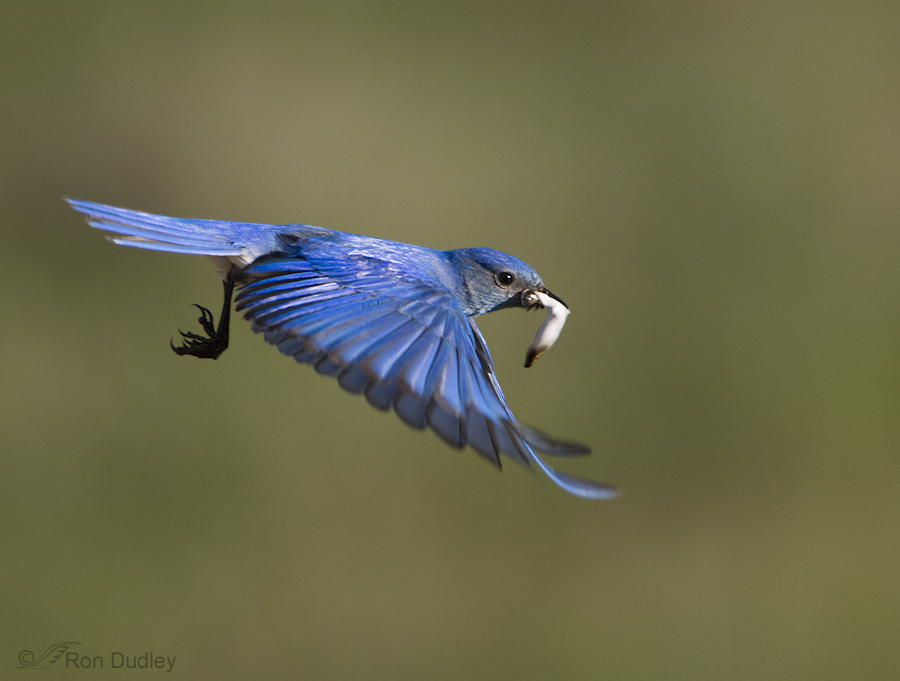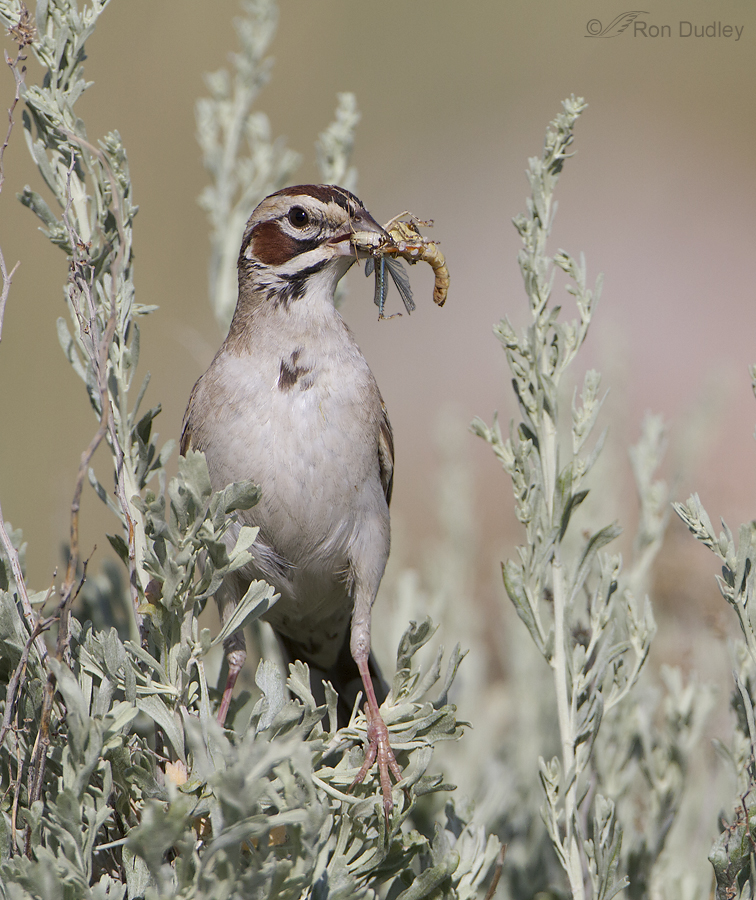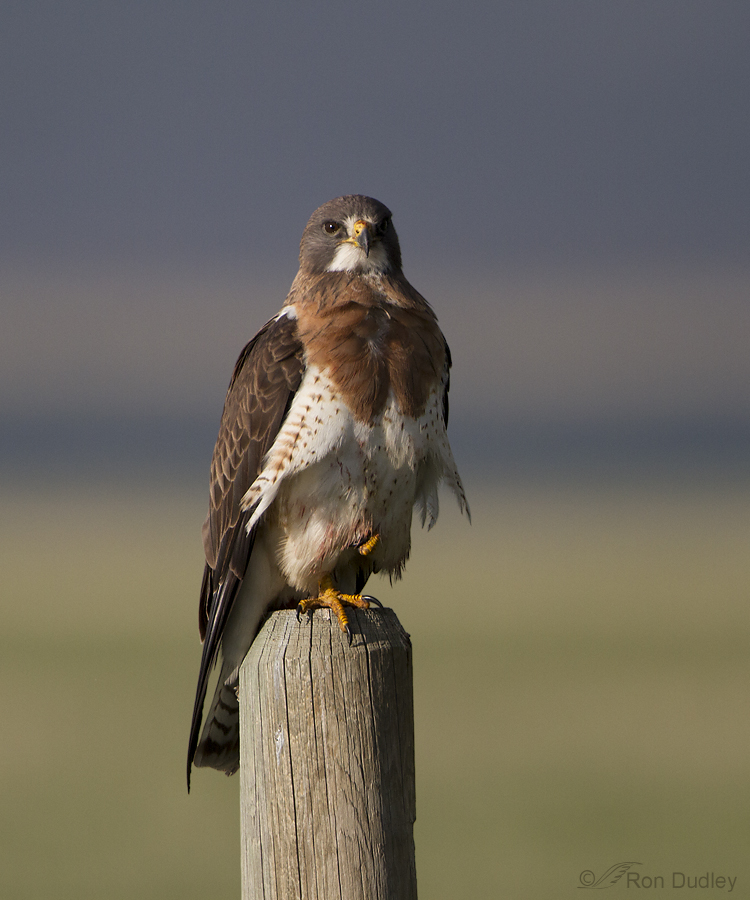Tag: prey
Swainson’s Hawk Buddies
Mountain Bluebirds Attending To Nesting Duties

On my recent Montana camping trip I was pleased to note that the good folks of Big Sky Country care deeply about their bluebirds. Nest boxes of every description and age seem to be abundant on both private and public land and along road corridors. Nesting season was in full swing, as were the traditional spats between Mountain Bluebirds and Tree Swallows for nesting rights to the boxes.
On these trips I can never resist photographing the bluebirds in particular as they perform their domestic duties.
American Kestrel With Snake Prey
Anyone who follows my blog knows that I observe and photograph kestrels often but I’ve never before seen one with snake prey. In my experience it’s always been voles, mice, small birds or (less often) insects. When we first noticed this bird it already had the snake on this bush perch.
Short-eared Owl In Flight With Prey
This sequence is from the summer of 2010 in southwest Montana. The adult male was kept busy hunting and delivering voles to his family of two chicks and the female on the nest.
Loggerhead Shrike – The Bill Of A Killer
I’ve never been able to get a really good look at both the hook and tomial teeth on the bill of a Loggerhead Shrike in any of my images. Until two days ago on Antelope Island…
Mountain Plovers Revisited
As some of you know, 10 days ago we found a pair of Mountain Plovers on Antelope Island. These plovers are rare in Utah, the few that are seen here are on their way to Montana, Wyoming and Colorado to breed so after a day or two these birds were gone. But they sure created a buzz in the birding community while they were here.
Short-eared Owl With Prey, Coming At Me
I’m always happy when I can get decent images of an owl in flight. If they’re carrying prey it’s a bonus. And if the bird is flying toward me I often consider it icing on the cake – partly because those kinds of shots are so very often baited, decoyed, set up or called in. As always for me, these were not. I’ve posted one of these shots before but I hoped it might be interesting for some to see a sequence of images as this adult male Short-eared Owl flew toward me with a vole for its mate before veering off to my right. 1/1000, f/5.6, ISO 800, 500 f/4, 1.4 tc, natural light, not baited, set up or called in This first image shows less detail and image quality because the owl was further away as it began to approach me but I decided to include it for context in the sequence. The lower background is sagebrush flats while the upper blues are Montana’s Centennial Mountains in shade. 1/1250, f/5.6, ISO 800, 500 f/4, 1.4 tc, natural light, not baited, set up or called in Four frames later the owl was significantly closer and flew almost directly at me before veering off – a pattern it followed more than once. I’d guess that it was his way of checking me out for any potential threat before delivering the vole. 1/1000, f/5.6, ISO 800, 500 f/4, 1.4 tc, natural light, not baited, set up or called in Which he’s doing intently here. Eye contact can’t be much…
Ravenous Yellow-headed Blackbird Fledgling
I was photographing adult male blackbirds when suddenly this very recently fledged youngster popped up in the cattails right in front of me. At first I thought it was just curious about me and my big truck but that turned out not to be the case.
How Important Is Direct Eye Contact?
I’m hoping to get some feedback from my viewers on this one. Almost from day one with my bird photography I’ve labored under the impression that good eye contact with my subject is vital, almost essential, for a strong image. But that’s a premise I’m beginning to question to some degree. I don’t think there’s any question that a good look at the eye almost always makes for a stronger image. Direct eye contact is often even better. But no image is perfect – they all have strengths and weaknesses and I’m wondering if I sometimes put too much importance on eye contact over other desirable traits of an image. Below are three images of male Northern Harriers. Each has strengths and weaknesses. My previous impulse would have been to shun the last two shots because of a poor look at the eye, even though they have other strengths the first image does not. Now I’m not so sure… 1/4000, f/6.3, ISO 500, 500 f/4, natural light, not baited, set up or called in In this photo the bird has an interesting wing position and it’s nicely separated from the horizon below. And I have great eye contact but the bird is “only flying” and there’s nothing else interesting going on. And besides, it could be said that looking at the photographer isn’t really a “natural behavior” anyway… Note: If you’re wondering what the brown is at top right, the background is water, not sky, and the brown at top and bottom are land. I could clone or…
Harlan’s Hawk On A Coot Kill (graphic)
On January 18 I photographed this Harlan’s Hawk at Farmington Bay WMA. Harlan’s is a relatively rare and very dark subspecies of the Red-tailed Hawk that breeds in Alaska and northern Canada but winters in the western U.S. and the Great Plains. I posted two other shots of this bird on January 20. 1/3200, f/7.1, ISO 400, 500 f/4, 1.4 tc, natural light, not baited, set up or called in On this day I only had a few moments with the hawk before it took off. 1/2500, f/8, ISO 500, 500 f/4, natural light, not baited, set up or called in Then, on January 22, we located the bird once again within just a few yards of where it had been four days earlier. This time it was at the bottom of a creek gully feeding on a freshly killed American Coot. The angle was steep and it’s not the most attractive setting but the behavior was interesting so I took lots of photos of this juvenile, if for no other reason than documentation of an unusual bird enjoying a meal. 1/2500, f/8, ISO 500, 500 f/4, natural light, not baited, set up or called in The bird was only nervous with our presence for a few moments, then resumed eating its meal with enthusiasm. Here it has a beak-full of feathers that it had a difficult time shaking off. 1/2000, f/7.1, ISO 500, 500 f/4, natural light, not baited, set up or called in I spent over 5 minutes with this…
Barn Owl Hunting Adaptations And Techniques
One more Barn Owl post and then I’ll give them a rest for a while. Lately I’ve spent a lot of time watching these birds hunt and I’ve become intrigued by the process and their adaptations for doing so. Hunting over deep snow presents unique challenges because their prey (typically voles) spends most of their time in tunnels under the surface, so the owls are often hunting by sound alone. According to Birds of North America Online (out of Cornell) Barn Owls hunt prey by sound more effectively than any other animal ever tested (I’m unsure if this statement takes into account the use of sonar by cetaceans and ultrasonic sounds by bats but BNA seldom gets things like this wrong). 1/3200, f/7.1, ISO 500, 500 f/4, 1.4 tc, natural light, not baited, set up or called in They fly low and slow over the surface while watching and listening but with this much snow they usually locate the voles only by sound. Notice that they can tuck their legs up into their ventral feathers so far that only the feet are visible. It’s amazing that they can do so because… 1/3200, f/7.1, ISO 500, 500 f/4, 1.4 tc, natural light, not baited, set up or called in as you can see in this “butt shot” those legs are incredibly long. This is an adaptation for grasping prey through deep vegetation or snow. Their claws (nails) are unusually long and sharp and the middle nail has a pectinate inner edge, most likely an adaptation for grasping prey…
Rough-legged Hawk Mantling, Then Take-off
My encounter with this Rough-legged Hawk was a frustrating one. It all began with a Northern Harrier on the snow-covered ground with prey (which turned out to be a Pied-billed Grebe) . It was quite far away, even if my tc had been attached (it wasn’t), so I put my pickup in gear to drive further down the road. Just then this hawk swooped in from behind (I couldn’t see it coming) to pilfer the prey from the harrier. By the time I got the pickup turned off and my tc attached the action between the two raptors was over – the harrier had vamoosed with the head of the grebe (based on the photos Mia was able to get) and the roughie was on the ground with what was left. 1/3200, f/6.3, ISO 500, 500 f/4, 1.4 tc, natural light, not baited, set up or called in Here the hawk is “mantling” the grebe. Mantling is a behavior of raptors where they spread their wings, fan their tail and arch their body over their prey – effectively hiding it from other predators, particularly other raptors. In this image the tail isn’t completely fanned and the bird is looking back at us rather than arching its body. There’s a patch of blood on the snow and you can see part of the grebe under the right wing. 1/5000, f/6.3, ISO 500, 500 f/4, 1.4 tc, natural light, not baited, set up or called in The hawk quickly gobbled down what was left of the grebe, inspected the…
A Vole Makes A Coyote Pay a Price For Its Meal
Yesterday morning I witnessed quite the little drama on Antelope Island. Two of them, really. This post will attempt to document what I saw. I lost sharp focus on a couple of these shots and some of the action was far away but I hope the images I include here will give you a feeling for all the excitement that unfolded. Going north on the ranch road we spotted four coyotes. Three of them crossed the road and walked slowly west while one of them left the area. At first I didn’t think they were in hunting mode, rather that they had a destination in mind. But this one detected a vole under the 6″ deep snow. From its body language it was obvious that it was able to hear the vole, even through all that snow. I’ve deliberately cropped this image to include the second coyote in the background. Notice in this shot, and the next two, that the background coyote is intensely watching something in front of and above it (there’s a relatively high mountain in that direction). Coyote #1 begins a pounce toward the source of the sound. The next image in the burst. It lands in the snow but apparently missed the vole. It stopped to listen again for a few seconds then pounced one more time. With its nose buried, it pushed through the snow like a snowplow for several feet. I believe that it was following the scent of the…
A Pied-billed Grebe Attempts To Dismember A Frog
Pied-billed Grebes are opportunistic feeders, taking large crustaceans (especially crayfish), fish, insects and other invertebrates. They also consume a lot of frogs when they’re available. When the prey is too large to swallow whole (frogs and crayfish especially) they grasp the appendages with their beak and shake it vigorously until the limbs break off. I’ve also seen adults tear off bits of the body trunk of frogs to feed to their chicks. This bird is a juvenile, still learning the finer points of consuming prey. This stage of plumage development is referred to as the “stripe-head stage”, for obvious reasons. Adults lose those stripes. The frog it has captured is probably one of the first amphibians the bird has had to deal with without assistance from a parent and that inexperience seemed obvious as the young bird dealt with the frog. I’ve presented all the photos in this series in the order they were taken. As you can see, the young frog hasn’t yet fully metamorphosed into an adult and retains the tadpole tail. The grebe would repeatedly grasp a limb (it tried all 5 of them several times)… and then shake the frog violently in an apparent attempt to tear the appendage off like it has seen its parents do so many times before. Here it’s working on the left front leg. Other times the bird would grasp the body and shake. Hard! At times the grebe would appear to rest and “think” about its…



